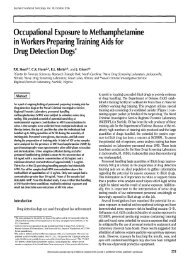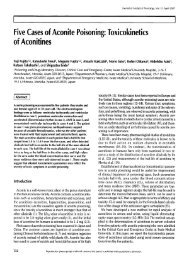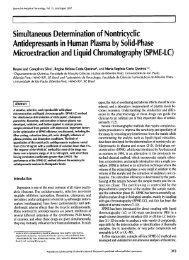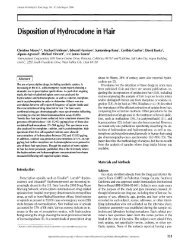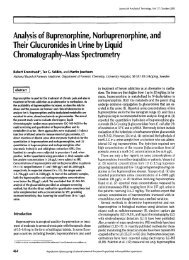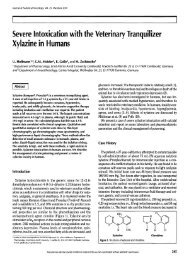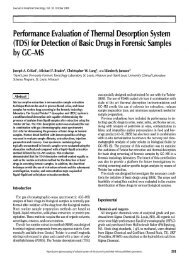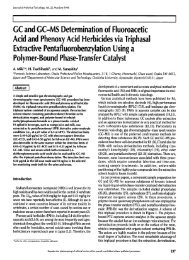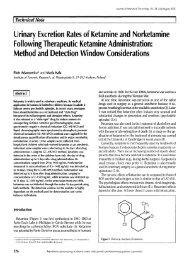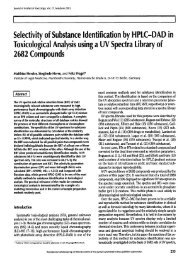Nitrite Adulteration of Workplace Urine Drug-Testing Specimens I ...
Nitrite Adulteration of Workplace Urine Drug-Testing Specimens I ...
Nitrite Adulteration of Workplace Urine Drug-Testing Specimens I ...
Create successful ePaper yourself
Turn your PDF publications into a flip-book with our unique Google optimized e-Paper software.
Journal <strong>of</strong> Analytical Toxicology, Vol. 22, March/April 1998<br />
subject's average daily output <strong>of</strong> nitrate was approximately 750<br />
lJmoles, but the nitrate output went to 4500 pmoles, a sixfold<br />
increase, on the third day <strong>of</strong> illness. By the fifth day <strong>of</strong> illness,<br />
nitrate output began to approach pre-illness levels. They repli-<br />
cated this pattern in the rat by injecting a pyrogenic factor<br />
from Escherichia coli, and obtained a ninefold increase in<br />
nitrate output over baseline. The highest level obtained, 4500<br />
pmoles per day, assuming average daily urinary output <strong>of</strong> 1500<br />
mL, would produce a nitrate concentration <strong>of</strong> about 186 IJg/mL.<br />
<strong>Nitrite</strong> was not independently measured, but assuming that<br />
nitrite is less than 1% <strong>of</strong> the total as indicated in the Moshage<br />
et al. (8) study, it would be less than 2 pg/mL.<br />
Urinary tract infection. Such enterobacteriaceae as<br />
Escherichia coli, Klebsiella, Proteus, Staphylococcus, and Pseu-<br />
domona are frequent causes <strong>of</strong> urinary tract infections. When<br />
numbers <strong>of</strong> these organisms are present in bladder urine in the<br />
range <strong>of</strong> ix 10S/mL, nitrate is reduced to nitrite by the microbial<br />
enzyme nitrate reductase. A semiquantitative test for nitrite was<br />
recommended as early as 1922 as an indicator <strong>of</strong> a significant<br />
urinary tract infection (13) and is still used extensively,<br />
employing commercially available urine test strips. These strips<br />
are based upon the Griess test for nitrite (14). The Chemstrip<br />
indicates a limit <strong>of</strong> detection <strong>of</strong> 0.5 pg/mL. Ten clean-catch spec-<br />
imens were obtained from a clinical urinalysis laboratory and the<br />
nitrite quantitated by the EPA method (Table I) to assess the con-<br />
centration <strong>of</strong> nitrite associated with medical specimens which<br />
are test-strip nitrite positive. In order to determine if an increase<br />
in nitrite may occur upon incubation, the specimens were stored<br />
at room temperature for 8 days and retested. There was no sig-<br />
nificant change (p = 0.40) due to the extended holding; six <strong>of</strong> the<br />
specimens decreased and four increased in nitrite concentration.<br />
The data from 18 clean-catch specimens for which culturing<br />
indicated an enterobacteriaceae infection <strong>of</strong> approximately<br />
100,000 colony-forming units per milliliter <strong>of</strong> urine are also<br />
listed in Table I. Averages and ranges for specimens 1-8 (initial<br />
and 7-day incubations) and all 18 specimens indicated no appre-<br />
ciable difference in the average or the ranges (p = 0.93). With this<br />
group, two specimens decreased in nitrite concentration while<br />
six specimens increased. The highest nitrite level in any <strong>of</strong> the 28<br />
specimens in these two categories was 35.5 IJg/mL. These data<br />
are consistent with the Chemstrip product literature, which<br />
indicated that urine specimens infected with nitrate reducing<br />
organisms do not usually produce more than 100 IJg/mL nitrite<br />
(15). As far as is presently known, nitrate reductase enzymes<br />
capable <strong>of</strong> reducing nitrate to nitrite have not been identified in<br />
humans or other mammals (16). In addition to the nitrite<br />
formed from microbial nitro reductase activity, some portion <strong>of</strong><br />
the nitrite measured in urinary tract infection is contributed by<br />
stimulation <strong>of</strong> iNOS activity by endotoxins from the enterobac-<br />
teriaceae organisms (17).<br />
<strong>Nitrite</strong> in urine from external sources<br />
In the environment, nitrogen in the combined state occurs<br />
mostly as potassium and sodium nitrates. From the environment,<br />
Table I. <strong>Nitrite</strong> Concentrations in <strong>Urine</strong> <strong>Specimens</strong> that Were <strong>Nitrite</strong> Positive by Test Strip and in <strong>Specimens</strong> Positive for<br />
Enterobacteriaceae by Culture<br />
<strong>Nitrite</strong> (pg/mL) <strong>Nitrite</strong> (pg/mL)<br />
Test strip nitrite positive Day 0 Day 8 Enterobacteriaceae positive Day 0 Day 7<br />
Average<br />
Range<br />
1 18.4<br />
1 5.9 4.6 2 33.5<br />
2 7.2



